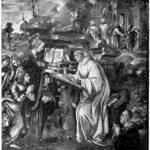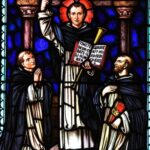St. Cloud
St. Cloud
When they lived:
St. Cloud, a revered and enigmatic figure of the Catholic Church, lived during the 6th century AD. Born in the year 522, his life spanned a period of great historical significance, filled with turbulent events and remarkable developments.
Where they lived:
St. Cloud’s origins lie in the region of Aquitaine, France, which was renowned for its picturesque landscapes and rich cultural heritage. The lush greenery and serene rivers of Aquitaine would later become symbolic of the saint’s connection with nature and the divine.
Notable world events during the time of their life:
- The Plague of Justinian (541-542): In the early years of St. Cloud’s life, a devastating pandemic, known as the Plague of Justinian, swept through the Byzantine Empire and surrounding regions. This deadly outbreak had a profound impact on the population and shaped the course of history for generations to come.
- The Hagia Sophia’s Construction (532-537): As St. Cloud matured into adulthood, the iconic Hagia Sophia in Constantinople (modern-day Istanbul) was completed. This magnificent architectural masterpiece would later become a symbol of religious harmony, showcasing the Byzantine Empire’s grandeur and cultural influence.
- The Codex Justinianus (529-534): During St. Cloud’s lifetime, the Roman Emperor Justinian I compiled the Codex Justinianus, a pivotal legal code that helped consolidate Roman laws. This landmark legal reform laid the foundation for modern legal systems worldwide.
- The Founding of Buddhism in Japan (552 AD): St. Cloud’s era also witnessed the introduction of Buddhism to Japan, marking a significant cultural exchange between the Asian continent and the island nation. This event would shape Japan’s spiritual landscape and influence its artistic expressions.
- The Life of Prophet Muhammad (570-632 AD): Overlapping with the later years of St. Cloud’s life, the birth and life of Prophet Muhammad in the Arabian Peninsula would lead to the emergence of Islam, a religion that would go on to shape the lives of millions and significantly impact world history.
Their patronage:
St. Cloud, the patron saint of brewers, winemakers, and exiles, embodied a unique blend of spiritual devotion and appreciation for the wonders of the natural world. Throughout his life, he fostered a connection with the earth and its bounty, eventually becoming a beloved figure among those involved in agriculture and viticulture.
As the patron saint of exiles, St. Cloud’s own life journey, filled with trials and tribulations, offered solace to those facing displacement and hardship. His intercession was sought by those who found themselves far from home, offering them hope and courage to persevere in times of adversity.
Legend has it that he had a special affinity for brewers and winemakers, attributing his ability to convert water into wine during his time as a hermit. This association made him a revered protector of those involved in these ancient crafts, and his blessings were believed to enhance the quality and taste of their creations.
In conclusion, St. Cloud’s life encompassed a period of significant historical events, and his patronage continues to touch the lives of individuals worldwide. From his early days in Aquitaine to the spread of his veneration across cultures and centuries, St. Cloud remains an intriguing and captivating figure in the tapestry of history.
Early life
St. Cloud (known as St. Clodoald) was born in 522 A.D. He was the son of King Chlodomer of Orleans and his wife, Guntheuc. After his parents’ deaths, he was one of the three brothers raised in Paris by their grandmother, the widowed Queen Dowager Clotilde. However, the boys’ uncles, Childebert I, King of Paris, and Clotaire, King of Soissons, coveted the kingdom of Orleans and planned to murder their nephews. Cloud escaped, but his two brothers were killed. He sought sanctuary with St. Remigius, the Bishop of Rheims, located a short distance from Paris.
Cloud renounced all claims to the throne and lived as a studious hermit and disciple of St. Severin of Paris. He drew closer to God through silence and solitude. He appreciated his separation from the world and a life of silence far away from the perilous life in the royal palace. He was taught all the monastic virtues.
Cloud left the hermitage when he was 20 years old. He appeared before the bishop of Paris, surrounded by civic leaders, religious leaders, and members of the royal family. It should be noted that Cloud was still a prince and heir to the throne. He put on his royal robes and carried scissors in one hand and a coarse garment in the other.
The bishop dressed him in the coarse garment as a symbol of the spiritual path that he was now taking. This also showed that he was denouncing the material riches associated with royalty. Cloud’s long hair, which was a symbol of royalty, was cut by the bishop. This symbolized that Cloud was severing ties with the royal family and making false pleas.
Miracles
When St. Severin the hermit died, Cloud left Paris to find solitude deeper in the forest. He sought silence, which enabled him to communicate with God more intimately while praying for the needs of people. God answered his prayers mysteriously by sending people to find him in the forest. Most of them were suffering from incurable diseases, and their souls were oppressed. With the gift given to him by Jesus Christ, Cloud healed and delivered them.
Cloud, as a hermit for eleven years, read the scriptures and sought revelation in the word of God. He left the pleasures of the royal court and gave his life to Christ. This explains the paintings of artists who portray St. Cloud holding a Bible.
Priesthood
By public demand, Cloud was ordained a priest in 551 A.D. by Bishop Eusebius of Paris. He served the church with humility and charity. He became pastor of a small village in Novigentum known today as the community of Saint Cloud. The village consisted of peasant farmers and fishermen.
The village benefited from his gifts of healing, counseling, and preaching.
Cloud’s uncles repented of their sin and made peace with their nephew. They restored Cloud’s inheritance, which included many castles, estates, and lands. He sold some of these properties and distributed his wealth to the poor. With the permission of Bishop Eusebius, he used a small portion of the wealth to build a church dedicated to St. Martin of Tours.
The charity and love that Cloud displayed attracted many people to live near him. They wanted to experience the joy and peace of Jesus Christ. As the numbers increased, Cloud saw it fit to form a religious community devoted to serving God and His people. This community was attached to the Church of St. Martin of Tours.
Death and patronage
Cloud died on September 7, 560 A.D. He was 38. His feast day is celebrated on September 7.
On September 12, 1891, Pope Leo XIII named St. Cloud the patron saint of the Church of Saint-Cloud in Minnesota. He is also the patron saint of Saint Cloud Hospital. Nail makers are also under the patronage of St. Cloud.
5 Interesting Facts About St. Cloud
- According to legend, St. Cloud accurately predicted the date of his
death. - He was buried in the community of St. Cloud, France.
- After his canonization, St. Cloud’s tomb transformed into a place of
pilgrimage where huge crowds frequented - He had the gift of healing and delivering people from all kinds of
afflictions.
Prayer to St. Cloud
Dear St. Cloud, You renounced ambition and violence to toil for the Lord. May I be ruled by faith, not ego. Amen.



